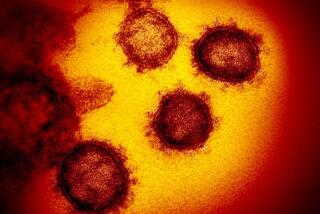Close-up of virus could ease HIV vaccine research
- Share via
The search for an HIV vaccine has taken an important step forward after researchers at the Scripps Research Institute in La Jolla managed to capture molecular images of a protein spike that allows the deadly virus to invade human immune cells to hack their genetic code.
The ability to control and analyze that shape-shifting envelope trimer protein, which has evaded the best efforts of biochemistry for more than a decade, could offer researchers the ability to see whether they can induce natural antibodies to attack the virus’ most vulnerable spot, a crucial step toward engineering a vaccine.
“In order to develop a vaccine, you have to understand what bits on that very important trimeric protein can be recognized by broadly neutralizing antibodies,” said Bridget Carragher, a Scripps Research Institute cell biologist who was part of the research team. “And in order to understand that, you need to understand what the structure of the thing looks like. Then, once you do, you can start designing a vaccine that will mimic that thing and elicit an antibody response and get the human being to fight the real virus when it comes along.”
But virologists have faced an enemy they could not stabilize and could not fully define on a molecular level. The Scripps-led team, funded in part by the National Institutes of Health, accomplished both. Their results were outlined in two papers published Thursday in the journal Science.
For a decade or more, researchers, led by John P. Moore at Weill Cornell Medical College, first had to wrestle to get this fragile and irregular protein, masked by 81 sugar compounds, to sit still. They finally managed to create a stable complex that included the trimer and an antibody, then handed it over to imaging specialists, led by Scripps structural biologist Ian A. Wilson, who managed to capture a crystallized form of the trimer complex using advanced electron microscopes.
“In order to evade the immune system and be furtive and sneaky, it coats itself in glycans and sugars, which make it nearly invisible to the immune system,” said Andrew B. Ward, a Scripps structural biologist who analyzed the protein complex.
“It’s an interplay of evolution,” Ward said. “As antibodies in your body are raised against the viral envelope protein, it makes changes that allow it to circumvent your defenses. Embedded at the core of this structure is the viral fusion machinery, so once it does find the host, what it wants to do is undergo a morphing which allows it then to fuse to the host cell and empty its genetic material inside, and once the genetic material is inside, that host cell will start making new copies of the virus.”
Parts of the trimer, notably its coupling mechanism and the human co-receptors that help it bind with T-cells, had been imaged before. But the complete structure, including the fusion mechanism, had not been captured at the resolution accomplished by the Scripps team, which also included researchers from Harvard University and the Academic Medical Center in the Netherlands.
Researchers have confirmed that the engineered trimer protein reacts with antibodies, but still need to test whether it accurately mimics properties of the natural protein on the virus. Then, they can begin the arduous work of seeing how it interacts with animal, and eventually, human immune systems.
“It’s a tricky little virus and it has all kinds of ways of distracting the immune system by multiple methods,” Carragher said. “So to get these broadly neutralizing antibodies that are actually effective is quite hard.”
For now, though, scientists may have a slight advantage in the arms race between the virus and the human immune system. “We understand what the immune system sees,” Ward said.







